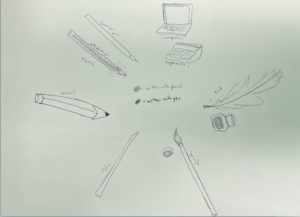By: Cheska Dong and Michelle Hua

Start here (Left) → → Read this way → → → → → → → → → End here (Right)
Start here again (Left) → → Read this way → → → → → → → End here (Right)
After reading one sentence, which is usually written from left to right, alien readers should start reading again from left to right, starting from the sentence below the previous one.
For humans, writing is a way to record our oral language. As many languages evolved different forms of writing, we have developed many tools to create writing. Writing instruments evolved throughout time and through civilizations; here, we will introduce a few notable instruments in human history.
In the primitive society of mankind, humans recorded words by carving. So the main tool they utilized is sharpened sticks, bones, and finally styluses. Cave drawings were achieved by using a tool dipped in pigment to leave a mark on stone walls. Nowadays the marks left on the wall provide the evidence for that. People also used styluses to carve words into tablets, usually of stone or clay.
While the invention of art brushes can also be dated back to the Paleolithic era, brushes used specifically for writing were developed in ancient China at around 300 B.C. These instruments look like long sticks with a bundle of hair attached to the end. To write, one would hold the stick, dip the hair into a pigment (traditionally ink) and drag it across paper or other absorbable surfaces to leave a mark. Since the hair allows for flexibility in writing, ancient people were able to easily depict complex characters with brushes.
Then around the 6th century in Seville, Spain, feathers were found to increase hardness for writing and to be less prone to corrosion. Thus the quill, used with ink, was invented and soon became the norm for writing of the time. It can be looked upon as the first customized pen. However, a quill needs to be regularly dipped in ink during writing, which did cause some inconvenience as it requires a separate inkwell and can’t be used to write for long periods of time without interruption.
Developing from quills and similar ink-based tools, modern pens came into existence around the 17th century. Pens are usually a short, stick shaped object that holds ink inside it, which is distributed by a tip on the end of it. One of the first designs of the modern pen was the fountain pen, which like a quill, used a pointed tip to distribute ink. Unlike a quill, fountain pens do hold ink inside it, and thus was more convenient for use. Later, ballpoint pens were developed. Ball point pens have a tiny ball at the nib, which when writing, rolls across the surface of paper or other materials to distribute ink. This pen was less prone to leakage than fountain pens and is one of the most popular writing utensils today.
Technological advances and the discovery of graphite provided possibility for the pencil investment. And in 1795, the modern pencil was invented by Nicholas-Jacques Conte, a scientist serving in the army of Napoleon Bonaparte. He input the right proportion of clay to the graphite powder to give the pencil core a certain degree of hardness. With the advantages of lightweight and easy to erase, pencils are still used today and play an irreplaceable role in writing.
Eventually, writing was simplified to type. Typing uses a single version of each character in a language to piece together writings, making it more efficient to create and reproduce, and more legible as well. In slightly less modern times, typewriters, a machine with keys corresponding to characters, were used to create type. Paper would be inserted into the typewriter and when a key was hit, ink would print the character onto the paper. Nowadays, computers are the main form of typing. Rather than printing directly on paper, computers create the characters digitally and could be printed later, making writings easier to edit. The keys of typewriters and computers are generally based on the English alphabet.